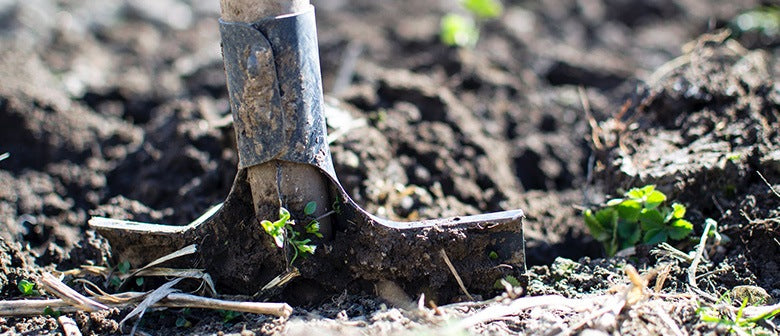Lasagne Garden
Yes, you read that correctly. ‘Lasagne gardening’ actually refers to the method of building the garden which is, essentially, adding layers of organic materials that will “cook down” over time, resulting in rich, fluffy soil that will help your plants thrive. In urban gardens faced with poor or contaminated soil, it’s also a great way to fill a raised bed with a healthy growing medium for edibles. Heavy feeders like tomatoes and peppers will love this nutrient-rich garden. Autumn, with its abundance of fallen leaves—a key ingredient—is a good time to begin.
Also known as “sheet composting,” lasagne gardening is great for the environment because you’re using your yard and kitchen waste and essentially composting it in place to make a new garden.

No Digging Required
One of the best things about lasagne gardening is how easy it is. You don’t have to remove existing weeds. You don’t have to double dig. In fact, you don’t have to work the soil at all. The first layer of your lasagne garden consists of either brown corrugated cardboard or three layers of newspaper laid directly on top of the grass or weeds in the area you’ve selected for your garden. Wet this layer down to keep everything in place and start the decomposition process. The grass or weeds will break down fairly quickly because they will be smothered by the newspaper or cardboard, as well as by the materials you’re going to layer on top of them. This layer also provides a dark, moist area to attract earthworms that will loosen up the soil as they tunnel through it.
Necessary Supplies
Anything you’d put in a compost pile, you can put into a lasagne garden. The materials you put into the garden will break down, providing nutrient-rich, crumbly soil in which to plant. The following materials are all perfect for lasagne gardens:

- Grass Clippings
- Leaves
- Fruit and Vegetable Scraps
- Coffee Grounds
- Tea leaves and tea bags
- Weeds (if they haven’t gone to seed)
- Manure
- Compost
- Seaweed
- Shredded newspaper or junk mail
- Pine needles
- Spent blooms, trimmings from the garden
Just as with an edible lasagne, there is some importance to the methods you use to build your lasagne garden. You’ll want to alternate layers of “browns” such as fall leaves, shredded newspaper and pine needles with layers of “greens” such as vegetable scraps, garden trimmings, and grass clippings. In general, you want your “brown” layers to be about twice as deep as your “green” layers, but there’s no need to get finicky about this. Just layer browns and greens, and a lasagne garden will result. What you want at the end of your layering process is a 50 – 60cm tall layered bed. You’ll be amazed at how much this will shrink down in a few short weeks.
When to Build
You can make a lasagne garden at any time of year. Autumn is an optimum time for many gardeners because of the number of organic materials you can get for free thanks to fallen leaves and general yard waste from cleaning up the rest of the yard and garden. You can let the lasagne garden sit and break down all winter. By spring, it will be ready to plant in with a minimum of effort. Also, autumn rains and winter frosts will keep the materials in your lasagne garden moist, which will help them break down faster.
If you choose to make a lasagne garden in spring or summer, you will need to consider adding more “soil-like” amendments to the bed, such as peat or topsoil, so that you can plant in the garden right away. If you make the bed in spring, layer as many greens and browns as you can, with layers of finished compost, peat, or topsoil interspersed in them. Finish off the entire bed with 7-10cms of finished compost or topsoil, and plant. The bed will settle some over the season as the layers underneath decompose.
Planting and Maintaining
When it’s time to plant, just dig down into the bed as you would with any other garden. If you used newspaper as your bottom layer, the shovel would most likely go right through, exposing nice, loose soil underneath. If you used cardboard, you might have to cut a hole in it at each spot where you want to plant something.
To maintain the garden, simply add mulch to the top of the bed in the form of straw, grass clippings, bark mulch, or chopped leaves. Once it’s established, you will care for a lasagne garden just as you would any other: weed and water when necessary, and plant to your heart’s content.
Advantages
- Fewer weeds, thanks to the newspaper suppressing them from below and the mulch covering the soil from above.
- Better water retention, because compost (which is what you made by layering all of those materials) holds water better than regular garden soil, especially if your native soil is sandy or deficient in organic matter.
- Less need for fertilizer, because you planted your garden in almost pure compost, which is very nutrient-rich.
- Soil that is easy to work: crumbly, loose, and fluffy.
Lasagne gardening is fun, easy, and allows you to make new gardens at a much faster rate than the old double-digging method. Now your only problem will be finding plants to fill all of those new gardens!

